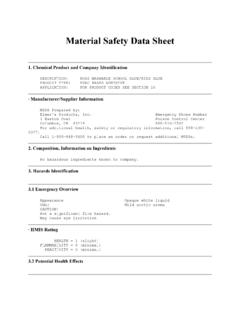Transcription of CDC - Fact Sheet - Scabies - Sayles School
1 fact SheetWhat is Scabies ? (#what)What is crusted (Norwegian) Scabies ? (#crusted)How soon after infestation do symptoms of Scabies begin? (#how_soon)What are the signs and symptoms of Scabies infestation? (#signs)How did I get Scabies ? (#how_get)How is Scabies infestation diagnosed? (#diagnose)How long can Scabies mites live? (#life)Can Scabies be treated? (#treat)Who should be treated for Scabies ? (#who)How soon after treatment will I feel better? (#better)What is Scabies ? Scabies is an infestation of the skin by the human itch mite (Sarcoptes scabiei var. hominis). The microscopic Scabies mite burrows into the upper layer of theskin where it lives and lays its eggs. The most common symptoms of Scabies are intense itching and a pimple-like skin rash. The Scabies mite usually isspread by direct, prolonged, skin-to-skin contact with a person who has is found worldwide and affects people of all races and social classes.
2 Scabies can spread rapidly under crowded conditions where close body andskin contact is frequent. Institutions such as nursing homes, extended-care facilities, and prisons are often sites of Scabies outbreaks. Child care facilities alsoare a common site of Scabies Top (#top)What is crusted (Norwegian) Scabies ?Crusted Scabies is a severe form of Scabies that can occur in some persons who are immunocompromised (have a weak immune system), elderly, disabled, ordebilitated. It is also called Norwegian Scabies . Persons with crusted Scabies have thick crusts of skin that contain large numbers of Scabies mites and with crusted Scabies are very contagious to other persons and can spread the infestation easily both by direct skin-to-skin contact and bycontamination of items such as their clothing, bedding, and furniture. Persons with crusted Scabies may not show the usually signs and symptoms of scabiessuch as the characteristic rash or itching (pruritus).
3 Persons with crusted Scabies should receive quick and aggressive medical treatment for their infestation toprevent outbreaks of Top (#top)How soon after infestation do symptoms of Scabies begin?If a person has never had Scabies before, symptoms may take as long as 4-6 weeks to begin. It is important to remember that an infested person can spreadscabies during this time, even if he/she does not have symptoms a person who has had Scabies before, symptoms usually appear much sooner (1-4 days) after Top (#top)What are the signs and symptoms of Scabies infestation?The most common signs and symptoms of Scabies are intense itching (pruritus), especially at night, and a pimple-like (papular) itchy rash. The itching andrash each may affect much of the body or be limited to common sites such as the wrist, elbow, armpit, webbing between the fingers, nipple, penis, waist,belt-line, and buttocks.
4 The rash also can include tiny blisters (vesicles) and scales. Scratching the rash can cause skin sores; sometimes these sores becomeinfected by burrows sometimes are seen on the skin; these are caused by the female Scabies mite tunneling just beneath the surface of the skin. These burrowsappear as tiny raised and crooked (serpiginous) grayish-white or skin-colored lines on the skin surface. Because mites are often few in number (only 10-15mites per person), these burrows may be difficult to find. They are found most often in the webbing between the fingers, in the skin folds on the wrist, elbow, orknee, and on the penis, breast, or shoulder head, face, neck, palms, and soles often are involved in infants and very young children, but usually not adults and older with crusted (Norwegian) Scabies may not show the usual signs and symptoms of Scabies such as the characteristic rash or itching (pruritus).
5 To Top (#top)How did I get Scabies ? Scabies usually is spread by direct, prolonged, skin-to-skin contact with a person who has Scabies . Contact generally must be prolonged; a quick handshakeor hug usually will not spread Scabies . Scabies is spread easily to sexual partners and household members. Scabies in adults frequently is sexually sometimes is spread indirectly by sharing articles such as clothing, towels, or bedding used by an infested person; however, such indirect spread canoccur much more easily when the infested person has crusted (Norwegian) Top (#top)How is Scabies infestation diagnosed?CDC - fact Sheet - of 29/23/2009 11:11 AMDiagnosis of a Scabies infestation usually is made based on the customary appearance and distribution of the rash and the presence of burrows. Wheneverpossible, the diagnosis of Scabies should be confirmed by identifying the mite, mite eggs, or mite fecal matter (scybala).
6 This can be done by carefullyremoving a mite from the end of its burrow using the tip of a needle or by obtaining skin scraping to examine under a microscope for mites, eggs, or mite fecalmatter. It is important to remember that a person can still be infested even if mites, eggs, or fecal matter cannot be found; typically fewer than 10-15 mites canbe present on the entire body of an infested person who is otherwise healthy. However, persons with crusted (Norwegian) Scabies can be infested withthousands of mites and should be considered highly Top (#top)How long can Scabies mites live?On a person, Scabies mites can live for as long as 1-2 months. Off a person, Scabies mites usually do not survive more than 48-72 hours. Scabies mites willdie if exposed to a temperature of 50 C (122 F) for 10 Top (#top)Can Scabies be treated?Yes. Products used to treat Scabies are called scabicides because they kill Scabies mites; some also kill eggs.
7 Scabicides to treat human Scabies areavailable only with a doctor s prescription; no over-the-counter (non-prescription) products have been tested and approved for follow carefully the instructions provided by the doctor and pharmacist, as well as those contained in the box or printed on the label. When treatingadults and older children, scabicide cream or lotion is applied to all areas of the body from the neck down to the feet and toes; when treating infants and youngchildren, the cream or lotion also is applied to the head and neck. The medication should be left on the body for the recommended time before it is washed clothes should be worn after addition to the infested person, treatment also is recommended for household members and sexual contacts, particularly those who have had prolongedskin-to-skin contact with the infested person. All persons should be treated at the same time in order to prevent reinfestation.
8 Retreatment may be necessary ifitching continues more than 2-4 weeks after treatment or if new burrows or rash continue to use a scabicide intended for veterinary or agricultural use to treat humans!To Top (#top)Who should be treated for Scabies ?Anyone who is diagnosed with Scabies , as well as his or her sexual partners and other contacts who have had prolonged skin-to-skin contact with the infestedperson, should be treated. Treatment is recommended for members of the same household as the person with Scabies , particularly those persons who havehad prolonged skin-to-skin contact with the infested person. All persons should be treated at the same time to prevent may be necessary if itching continues more than 2-4 weeks after treatment or if new burrows or rash continue to Top (#top)How soon after treatment will I feel better?Itching may continue for 2 to 4 weeks after treatment, even if all the mites and eggs are killed.
9 Additional medication may be prescribed to relieve severeitching. If itching continues more than 2-4 weeks or if new burrows or rash continue to appear, retreatment with scabicide may be necessary; seek the adviceof a Top (#top)Page last reviewed: November 10, 2008 Page last updated: November 10, 2008 Content source: Division of Parasitic Diseases ( ) , National Center for Zoonotic, Vector-Borne, and Enteric Diseases( )Centers for Disease Control and Prevention 1600 Clifton Rd. Atlanta, GA 30333, USA800-CDC-INFO (800-232-4636) TTY: (888) 232-6348, 24 Hours/Every Day - - fact Sheet - of 29/23/2009 11:11 AM




